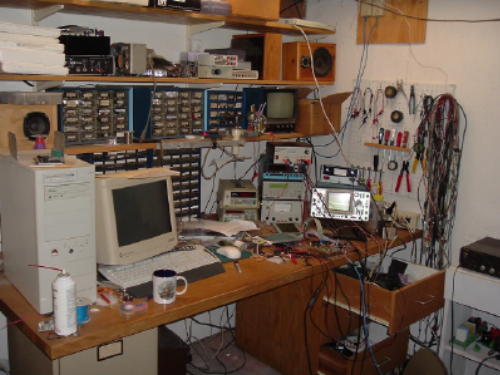The Lab and
Tools
Our speaker lab is a table in the basement. An old
Harmon-Kardon receiver serves as the signal switch, speaker A/B switch,
preamp and amp. When I built up the prototype active crossover I
discovered that it had no preamp output, so I drilled a couple of holes
in the rear, mounted two RCA jacks, and tapped into the amplifier
inputs with two 470 ohm resistors to protect the preamp and isolate the
preamp outputs. Works swell.
We use an Analogic digital waveform generator which makes OK sine
waves, but is not low distortion. Good for frequency
response testing, as any function generator will do. I also
have an electronics lab with a scope, power supplies and several
meters. Plus lots of parts. And a wood shop for the wood parts.
Table saw, router, sanders, drill press, hand power tools. etc.
A PC running Speaker Workshop
measures driver impedances and calcuates Thiele-Small parameters. We
haven't yet set it up with a microphone to measure frequency
response. This free program is pretty amazing. Using just a sound
card,
cables made from PC audio cables, a 10 ohm resistor and a test box with
a speaker-size hole, it measures speaker parameters, crossovers, and
just about everything else like a champ. It also does a decent job
designing ported and closed boxes. It does take a while to set up the
input and output volumes, and until I made the unshielded parts of the
cables real short and well soldered, the 60/120 Hz power line pickup
prevented the program from working.
I use the student Pspice 9.0 for simulation, which is available for
free. There are file size limitations on this version, mostly in
the number of transistors in a design. But if you use the OPAMP
primitive, it is an ideal op-amp and uses no transistors. You can
always add bias currents, voltages and other primitives to make
them more 'real'. But for audio they work swell.
For schematics and PC layouts, I use ExpressPCB.
Their free tools are very easy to use, libraries are decent. Their
Mini-board service is $59 for three 3.8 x 2.5, 2 sided boards, three
day delivery. The limitation is that if you want to build boards, you
have to use their service. Their PCB tool doesn't output Gerber files.
Or even print files so you can do toner transfer. There are however
tricks to get clean artwork layer prints (using screen capture and a
paint program) . No limits on schematics though.


Photo
Gallery
Main Page
Last Updated:
May 20, 2005
